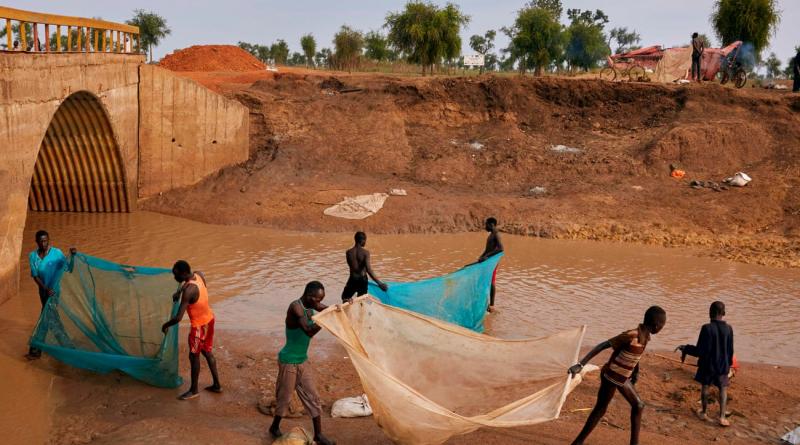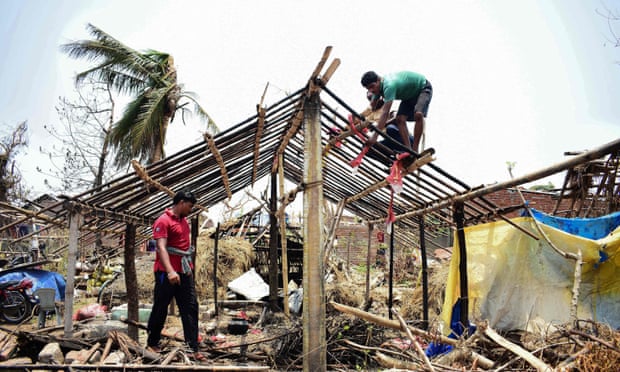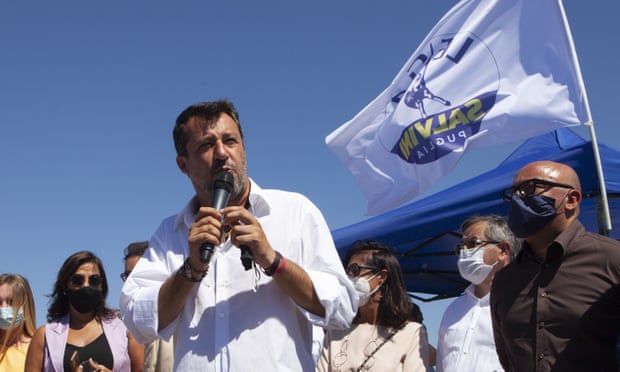How helpful is the term 'climate refugee'?

Politicians warn the climate crisis will lead to more people migrating. But experts say this framing of the issue risks being misleading and dangerous.
You think migration is a challenge to Europe today because of extremism,” John Kerry told a conference in Alaska in 2015, “wait until you see what happens when there’s an absence of water, an absence of food, or one tribe fighting against another for mere survival.”
As warnings go, it seemed like the kind we’re used to hearing from politicians in the West. From indulging in inflammatory rhetoric to focusing on the need for ‘control’, alarmist claims about immigration are a regular fixture of political discourse in countries like the US and the UK.
The reaction to an increased number of people crossing the Channel in small dinghies to apply for asylum is one of the most recent examples of this. The political fallout has been predictable; right-wing papers have run scaremongering front pages as government ministers claimed that it’s important to make border policies even tighter to stop people from making the journey, though the lack of safe and legal routes to the UK force them to do so in the first place. Much as during Europe’s summer of 2015, it has been depicted as a “crisis” – not for the people who have to risk their lives but for the place they are trying to get to.
But there was something slightly different about Kerry’s prediction five years ago. It represented a new strain of thinking that has developed over the past decade: the climate crisis will mean increased numbers of people migrating. This is where we might increasingly expect political and public discourse will go.

The same year of Kerry’s speech, European commission president Jean-Claude Juncker declared in his State of the Union address: “Climate change is one of the root causes of a new migration phenomenon. Climate refugees will become a new challenge – if we do not act swiftly.” Two years earlier, Chris Bryant, then Labour’s Shadow immigration minister, asserted: “If we get climate change wrong there is a very real danger we shall see levels of mass migration as yet unparalleled”.
There is no agreed-upon definition of who constitutes a ‘climate migrant’ or a ‘climate refugee’. Some of those lobbying for international or regional protections related to these terms say they cover a spectrum: from people who have to move – even if temporarily – because of natural disasters, through to those affected by the slow-onset impacts of the climate emergency.
When politicians bring up ‘climate refugees’, they often issue foreboding statements about large numbers of people who fall into this undefined group having to come “here” - usually Europe or the US. Picked up by parts of the far-right and slotting neatly into an immigration debate already fixated on numbers and stopping the movement of particular groups of people, some treat these claims as fact.
But on an overcast day in mid-March, a handful of academics and expertsgiving evidence to the House of Lords EU Home Affairs sub-committee on this very subject came to a different conclusion. As they spoke one after another in a grandly decorated room that’s typical of the Houses of Parliament, the consensus became clear. The term ‘climate migrant’ is not particularly useful. Some argued it is misleading and dangerous.
For anyone attuned to the debates about climate and migration, this will come as no surprise, for these are conversations being played out in select academic and activist circles around world. Meanwhile, some of the very people who might fall into the hard-to-define category of ‘climate refugee’ have themselves rejected the term, which is often used in such as way that strips them of their humanity.
So what are the potential problems, as well as uses, with the idea of climate migration? And what does this mean for how we should understand movement and the climate crisis more broadly?
The fish are migrating; so must we’
“The idea that there will be massive numbers of people arriving or floods – to use this water language – of migrants to European shores is overstated and sensationalised and not to be expected. It will be much more regional,” Dr Caroline Zickgraf told the Lords committee as a clerk in the corner of the room diligently recorded the discussion. An academic who works on migration and climate, Zickgraf firmly rejected the idea that if people have to move because of environmental degradation they will come to Europe or the UK.
Sitting next to her, also giving evidence, was Professor Roger Zetter, former director of the Refugee Studies Centre, who cautioned against making grand predictions about what will happen over the next few decades. Many still rely on global figures that have been widely rejected but because there’s so much variation across and within different countries, he said, it’s much better to look at a local level.
When you do that, as one report showed, you find that although cross-border migration has garnered more attention, “far more people are migrating within their own countries than across borders” and will likely continue to do so. The evidence shows that “when it [migration] is not internal, it is to neighbouring countries”, Zickgraf said.

She gives N’Dar in Senegal as an example, a fishing quarter in the country’s second biggest city where 97% of people are directly dependent on fishing. A combination of coastal erosion and decreasing numbers of fish mean people have to move within the country and toward neighbouring Mauritania. “As one person I interviewed said, ‘The fish are migrating; so must we’.”
While political discourse might be focused on ‘climate refugees’, Zickgraf said that countries like the UK will also experience climate displacement due to coastal flooding.
Threat multiplier
As well as debating where or how many ‘climate refugees’ will move, those in the field are also questioning how useful the concept itself is.
Reliant on loaded terms like ‘economic migrant’ and ‘bogus asylum seeker’, popular discussions around immigration often operate on one-dimensional stereotypes. But “migration is always multi-causal,” Zickgraf said. “It is always a combination of social, political, economic, environmental and demographic factors.”
By this logic, she argues, it is more productive to understand the climate crisis as “a threat multiplier” that exacerbates existing problems. Climate isn’t irrelevant: it “pose[s] major challenges for populations whose livelihoods are resource dependent, and in some cases that leads to displacement and outright forced migration”. But as some of those advocating for protections related to the term recognise, while there might be some examples where climate appears to be the reason people are forced to leave their homes, in most cases it’s more complicated than that.
For Dr Nithya Natarajan this more complex understanding of movement is obscured when we focus only on the climate crisis. “I don’t like the term climate refugee and climate migrant because I think it conceals the fact that it’s an environmentally deterministic argument for migration, which I wholly reject,” explains Natarajan, a lecturer in international development at King’s College London. “I think most of the people who are refugees and migrants because of climate change being the tipping point were poor to begin with and will be poor if we solve climate change. That’s my problem with it – this isn’t just about climate change, it’s about the global development model in their home countries.”
Exactly what this looks like and the role the climate crisis plays varies significantly depending on where you’re living. Natarajan has studied India and Cambodia, for example, and says focusing on the climate in these contexts overshadows the way development practices – often those that are Western-led – have actually been the key problem for decades.
Though hidden by macro growth figures, she points to the way structural adjustment programmes have created or increased precarity and how farmers and agricultural workers have been forced out of work and given no alternative jobs. Set against this backdrop, some have moved to urban areas where they’re subjected to high levels of exploitation and others have little choice than to take on high levels of debt under the guise of financial inclusion programmes.
Natarajan says with debt, for instance, loans are increasingly spun as a way to help people develop climate resilience. But with high interest rates, given to people with little or no collateral, and largely used for daily expenses, many end up having to move for work in order to pay them back. In this instance the “structural causes” of movement “are not climate change. Climate change in a sense exacerbates the pre-existing problems in rural areas.”
Asad Rehman, director of the charity War on Want, doesn’t entirely reject the idea of ‘climate migrants’, but says it is only meaningful if understood in an expansive way. “What we’ve been trying to do for over a decade is to try and get ahead of the narrative on climate migration so it doesn’t get narrowed.” One example he gives is economic inequality, which has “left people unable to deal with impact after impact of the climate crisis”.
Much like the climate crisis itself – where some of the countries least responsible are those suffering its effects the most – systemic, unequal power relations are relevant to understanding why, when and where people move. But this is rendered invisible if the climate, isolated from everything else, is all that’s thought about.
As far as Rehman is concerned, even if the climate crisis isn’t the sole reason people are moving, the focus should be on two things: first, creating a world where people can stay where they are if they want to and second, equipping people with what they need to be able to migrate if they want or have to.
“If we think about it in the lens of adaptation,” Minnie Rahman, public affairs and campaigns manager at the Joint Council for the Welfare of Immigrantssays, “we can also think about what people might need in the places where they are in order to be able to move safely or to stay safely”.

But when nearly half of the world lives on less than five dollars a day and millions don’t have access to electricity that can be near impossible for many. And as one recent report focused on Mali explains, there can often be a gendered aspect to who is able to move and how the climate crisis affects people.
“When we talk about climate migration we actually should be talking about how do you address survival migration,” Rehman explains. “It’s actually about access to energy and food, do people have income, do they have access to public services, those are the climate adaptive members that tackle displacement of people.”
None of this means regional agreements about climate migration, some of which have already been made, and international protections don’t matter. UNHCR, the international organisation’s refugee agency, doesn’t endorse using the term ‘climate refugee’, largely, it seems, because it’s not a term that exists in international law. Yet they do advocate for developing protections for people who have to move because of environmental changes but who aren’t covered by existing legal frameworks.
And those who are critical of the term ‘climate refugee’ are also often keen to stress that it isn’t about trivialising the seriousness of the climate crisis or treating movement and protections related to that as unimportant.
Climate nationalism
Nevertheless, there is growing concern about how the term operates in current political discussion. A 2013 study argued that ‘climate migration’, even across different approaches, is framed as apocalyptic. The people who move are stripped of their humanity and relative agency, lumped together as the same. In the process, they’re turned into faceless hordes and used as the evidence of the climate crisis.
This is partly because ‘climate migration’ contributes to an existing anti-migration narrative where many of the people who move – largely people of colour and those who are poorer – are seen as a problem to be dealt with. And so fear around migration and migrants becomes a rationale for taking climate breakdown seriously. This is an issue for some activists, who do not want concerns about the climate crisis to be channelled into the anti-migration logic that people moving is threatening.
But the same 2013 study found there was another potential response to theseracialised messages about people coming to Europe: it risks making climate breakdown and the supposed movement related to it also seem unavoidable. That leads people to argue that the only way to respond is with more borders.
“In this debate there are people basically saying: ‘Act on climate change because if you don’t there’s going to be all these black and brown people coming, it’s going to be terrible’,” Asad Rehman argues. “The answer for many of these people then is securitised borders [and a] more militarised response…that’s of course just enhancing what’s already happening around the current issues around migration.”
This is where the far-right make an appearance. Often known to deny the existence of the climate crisis and hone in on the supposed need to further restrict migration, there is a section of far-right thinking that marries the two together. Steeped in histories of colonial superiority and related to a broader form of climate nationalism, the environmental crisis is a vector throughwhich some far-right figures argue that too many of ‘them’ will come ‘here’.

Italy’s Matteo Salvini has said: “What is climate migrant? Where you go? If one is cold in winter and hot in summer, does it migrate? We are serious. We already have many. Is the climate migrant also one of Milan who does not like fog?” And the Freedom Party of Austria has argued “Climate change must never become a recognised reason for asylum,, claiming if it is “the dams will finally break and Europe and Austria will also be flooded with millions of climate refugees.” It is not hard to see how such dehumanising and misleading thinking might fit directly in to the current discussion about asylum in the UK.
Whether they’re warning of people ostensibly posing as ‘climate refugees’ or the real thing, these arguments quickly become another justification for protecting ethnonationalist, ostensibly white, borders from people of colour.
Rahman argues that the way forward is to ensure that any organising around climate migration has to be done in a way that doesn’t treat movement as a threat. She sees the left as sometimes culpable for reproducing this very discourse, which has also been part of the criticism of the Labour leadership’s response to the recent moral panic over Channel crossings.
“The left still doesn’t have a grasp of migrants rights in enough of a way to understand what they will need to do to help this situation once people actually do start moving in a way that speeds up after the climate crisis speeds up,” she says.
Rahman suggests that one of the core solutions, no matter where you stand in the debate about the term ‘climate migrants’, is to challenge the way movement is understood as an inherent problem. “The more the left talks about ‘mass migration’ in those terms and also reinforces those fears, the more it allows the right to create this idea that we need protecting from people who are moving even though we have taken no responsibility for why they might be moving at all.”
31 August 2020
The Guardian



